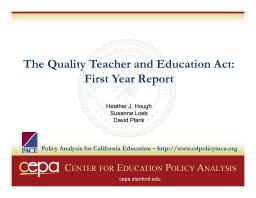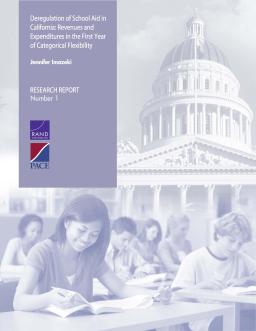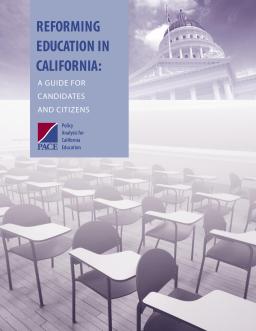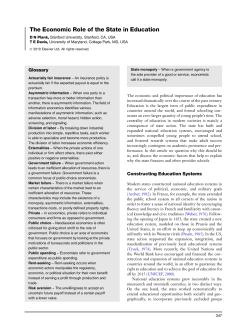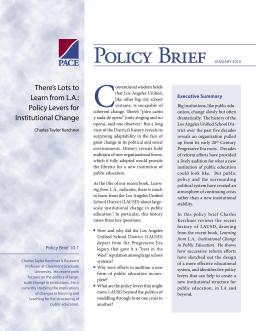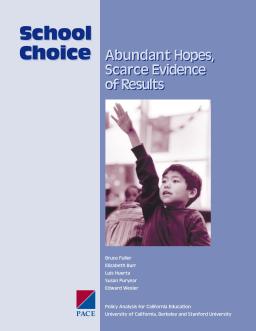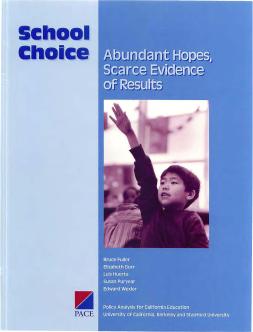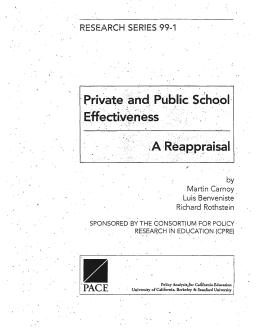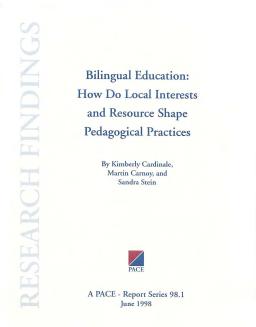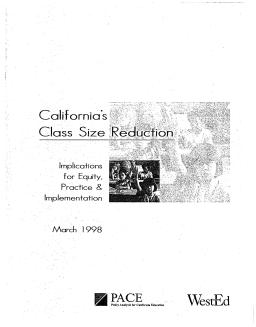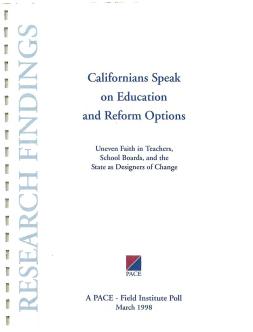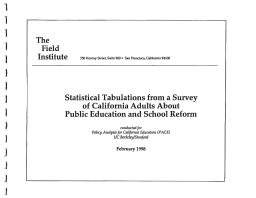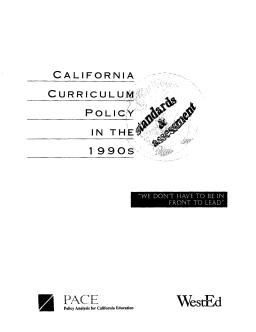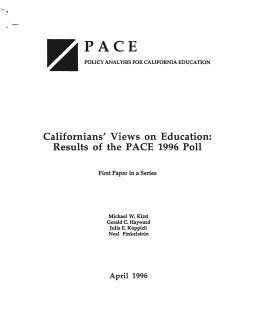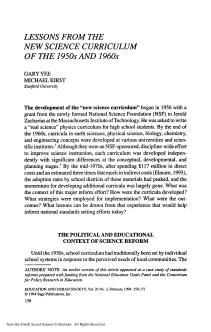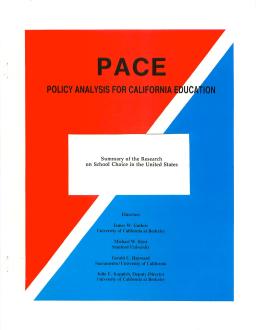First Year Report
Published
Summary
The Quality Teacher and Education Act (QTEA) was passed in 2008 in San Francisco, authorizing $198 per taxable property to be collected by the SFUSD for 20 years. CEPA and PACE collaborated with the SFUSD to evaluate the implementation and impact of QTEA on teacher compensation, support, and accountability. This report documents the first-year implementation of QTEA and its effects on the recruitment and retention of high-quality teachers, improvement of the teacher workforce, and removal of less effective teachers using a mixed-methods approach.
How 10 Districts Responded to Fiscal Flexibility, 2009–2010
Published
Summary
This report explores how 10 California school districts responded to the deregulation of $4.5 billion in education funding, which became entirely flexible in 2009. The study investigates how district leaders made budget decisions and what local factors influenced their responses. The research was conducted by a team of scholars from the RAND Corporation, UC Berkeley, UC Davis, and San Diego State University.
Revenues and Expenditure in the First Year of Categorical Flexibility
Published
Summary
This report discusses the effects of California's partial release of categorical funds to local school boards in 2009. The increased flexibility has provided an opportunity to observe how districts respond to the policy change, but the impact is difficult to isolate as most districts have been struggling to maintain core services during a severe budget crisis. The report includes preliminary results from an ongoing study of district responses to the increased categorical flexibility.
Published
Summary
The James Irvine Foundation sponsors the Linked Learning approach as a strategy for improving California high schools' performance. PACE was asked to gather evidence on the cost of linked learning programs. The report explores how traditional high schools use their resources and how much school districts spend on their high schools to achieve current performance. It proves challenging to judge whether reform strategies like Linked Learning cost more than, less than, or the same as traditional high school programs.
California’s Quality Education Investment Act
Published
Summary
This working paper examines the use of Quality Education Investment Act (QEIA) funds, which allocated $2.6B over seven years to California's lowest-performing schools. The authors conducted a study of four Los Angeles high schools to investigate how QEIA dollars were spent in the first year, who made the decisions, and how funds were used to improve teaching and the instructional program. The study found that district officials and principals had discretion in allocating funds, consistent with recent efforts to deregulate categorical-aid programs and give local educators fiscal discretion.
A Guide for Citizens and Candidates
Published
Summary
PACE has published a policy book to support informed debates about the issues facing California education. The book includes recommendations to improve education quality, targeting resources to those who need it most, giving local schools more flexibility, and designing policies for continuous improvement. While there's no one solution to fix public education, a series of good policies can bring about fundamental reform and improve outcomes for schools and students.
Published
Summary
This article explores the reasons why education has become a central focus of modern societies and the largest public expenditure around the world. The state has built and expanded national education systems, made attending school mandatory, and linked adult success to academic performance. The article delves into the economic factors behind state financing and provision of schools.
Policy Levers for Institutional Change
Published
Summary
The Los Angeles Unified School District has undergone decades of reform, resulting in an unstable atmosphere rather than institutional stability. A recent book, "Learning from L.A.: Institutional Change in Public Education," identifies five policy levers that can create a more effective educational system and a new institutional structure for public education, both in LA and beyond.
Abundant Hopes, Scarce Evidence of Results—Executive Summary
Published
Summary
Public education in the US is widely criticized and everyone wants to reform it, but there's no consensus on the best strategy for improvement. This report focuses on school choice, a reform avenue gaining steam in California and the US, to explore policies and institutional changes that can boost children's learning.
Abundant Hopes, Scarce Evidence of Results
Published
Summary
Public education receives criticism from various stakeholders. Despite satisfaction with local elementary schools, overall quality concerns prevail. There is no consensus on the best approach to improve schools. PACE report investigates school choice, which is a reform strategy gaining popularity in California and beyond.
A Reappraisal
Published
Summary
This report challenges the belief that public schools are ineffective due to a lack of accountability for producing high academic achievement. Some argue that private management is necessary for improvement, but this report seeks to analyze the range of responses that schools have to accountability and determine whether market forces are necessary for improvement.
How Do Local Interests and Resources Shape Pedagogical Practices?
Published
Summary
Bilingual education implementation varies by district due to discourse and policies. Four issues affecting implementation are teacher recruitment, "ghettoization" of bilingual education, race relations, and community consensus. National debates impact local administrative actions, defining bilingual education practice. The report analyzed four California school districts to show the impact of these four issues on program design.
A Study of Eight States and the District of Columbia
Published
Summary
This report presents the results of a study investigating the impact of charter schools on school districts, how they responded, and whether they experienced systemic change due to charter laws. The study focused on eight US states and the District of Columbia and included case studies of 25 affected school districts. The research was funded by The Saint Paul Foundation and conducted in 1997, six years into the charter school experiment. PACE hosted the study.
Implications for Equity, Practice, and Implementation
Published
Summary
In 1996, CA launched a $1 billion class size reduction (CSR) initiative to improve early literacy. The initiative provides $800 per student to schools reducing class size to 20 or fewer in first, second, and/or third grade, and kindergarten. CSR was funded due to a state revenue surplus and the belief that smaller classes would enhance early literacy. CA ranked second to last in national reading tests in 1994, and class sizes averaged around 28.6 students per K-3 classroom. While educators and the public show enthusiasm, the success of CSR in enhancing academic achievement is yet to be seen.
Uneven Faith in Teachers, School Boards, and the State as Designers of Change
Published
Summary
Public education quality has long been debated, worrying parents, activists, and politicians. Recent polls show it is a top concern in California and the US. Politicians and activists propose school reform, and a new election season has begun. PACE and the Field Institute surveyed 1,003 Californians in February to assess their views on education quality, trusted reformers, and evaluating major proposals. The report details key findings.
Published
Summary
This volume presents the results of a PACE survey conducted by The Field Institute among 1,003 California adults via random digit dialing. Statistical weights were developed to match the sample of California adults interviewed to known parameters of the adult population. Estimates of sampling error from results based on the overall adult public sample are +/- 3 percentage points. Other possible sources of error include differences in question wording, sequencing, or undetected errors or omissions in sampling, interviewing, or data processing. The study professionals minimized such errors.
California Families Face Gaps in Preschool and Child Care Availability
Published
Summary
This report highlights the unequal distribution of preschool and childcare opportunities in California. Despite spending $1.2 billion annually, half of preschool-age children live in households with working mothers, with enrollment dependent on income and location. Counties vary greatly in their supply, with affluent parents more likely to find preschool or childcare slots. Latino children are hit hardest, even in counties with ample supply, with supply in predominantly Latino areas half that of low-income Black or Anglo communities.
Standards and Assessments
Published
Summary
This study traces California's curriculum-related reforms in mathematics and science during the 1990s, examining the role of the California Department of Education and the state's shifting political and policy context. It analyzes the perceptions of state officials, experts, and the public and how they influenced state policy changes. The authors raise questions about problems associated with curriculum policy in California and presents policy recommendations mentioned during interviews and document analysis. The study does not assess the impact of curriculum on school practice.
Results of the PACE 1996 Poll
Published
Summary
A 1996 statewide poll by PACE surveyed Californians on their views and expectations for public schools, informing policy discussions. Results revealed four broad themes and their relevance to ongoing education policy discussions, such as redesigning statewide assessments, reforming traditional school governance, providing public funds for private schools, and complex issues of local control. PACE believes public perceptions should be considered in policy discussions, although education policy should not be solely based on public opinion polls.
Published
Summary
Intergovernmental relations in education policy are dominated by regulations, programs, and technical assistance. A metaphor called "ecology of games" captures how each level of government maximizes its influence, affecting state and local policy-making. Classroom practice is limitedly influenced by intergovernmental policy, as local demands, taxes, and needs also play a role. State policies are easier to influence administrators than to change teaching. Each level of government tries to maximize its sphere of influence.
Published
Summary
This is the ninth edition of Conditions of Education in California. In this volume, PACE has compiled information on current critical issues in state education policy and presented them within the context of major policy developments. "Evolving Context" introduces the current issues in the state and sets the stage for the remaining chapters, which are Assessment and Achievement, Finance, Teachers and Teaching, Integrated Children's Services, Child Care and Development Services, and School-to-Work.
Published
Summary
The National Science Foundation granted MIT's Jerold Zacharias in 1956 to develop a real science physics curriculum for high school students. By the 1970s, curricula were developed in various sciences, but each independently with differences in development, planning, and concepts. Despite the $117 million cost, adoption rates peaked and momentum for further curricula development waned. Lessons can be drawn from this experience to inform national standards today.
Published
Summary
The research base for understanding and prescribing policy for school boards is limited due to the large number of boards and members. Common school boards, especially those of small districts, are less researched. To address this, overall trends affecting most boards should be analyzed to determine the need for and direction of school board reform. Waiting for representative data on all boards will delay improvements to policy making. Major changes in school board roles, functions, and operations are necessary due to the interaction of these trends.
Published
Summary
This PACE paper provides information regarding the number and types of private schools in California, as well as their enrollments, size, and geographic distribution. It also summarizes current state regulations for private schools and highlights areas in which information gaps exist. Finally, the paper suggests possible ways in which existing private schools might expand or new private schools might enter the marketplace.
Published
Summary
The paper provides a synthesis of existing literature on school choice, with a focus on research that informs public policy development and evaluation. It presents information without taking a position for or against school choice and is intended for policymakers, parents, educators, and the public. The paper covers six sections, including types of school choice programs, efficacy, economic theories, private schools, public opinion, and unresolved research questions.
